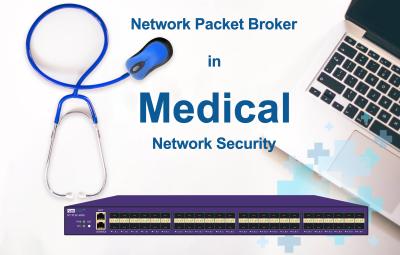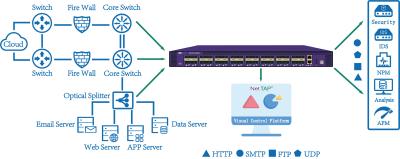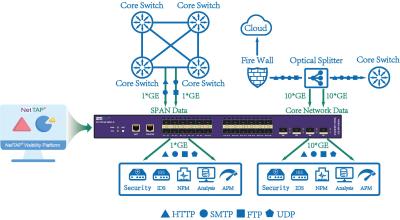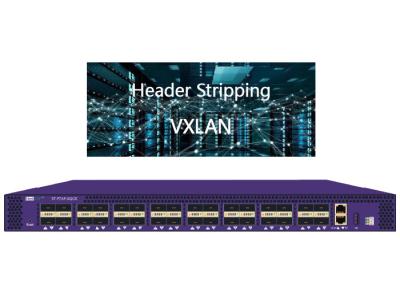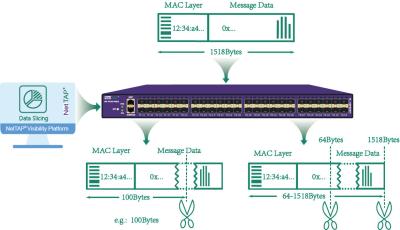


| Price | Can Discuss |
| MOQ | 1 SET |
| Delivery Time | 1-3 Working Days |
| Brand | NetTAP® |
| Place of Origin | China |
| Certification | CCC, CE, RoHS |
| Model Number | MATRIX-TCA-CG; NT-FTAP-32QCX |
| Packaging Details | Outer Carton plus Inner Foam |
| Payment Terms | L/C, D/A, D/P, T/T, Western Union, MoneyGram |
| Supply Ability | 100 sets per month |
| Place of Origin | China | Applications | Data Center of telecom, broadcasting, government, etc |
| Packaging Details | Outer Carton plus Inner Foam | Slicing range | 64-1518 bytes optional |
| Model Number | MATRIX-TCA-CG; NT-FTAP-32QCX | Supply Ability | 100 sets per month |
| Certification | CCC, CE, RoHS | Brand Name | NetTAP® |
| Payment Terms | L/C, D/A, D/P, T/T, Western Union, MoneyGram | Packet Slicing | Removing Payload Data from Sensitive Data Packets |
| De-duplication | eliminating redundant copies and duplicate packet storage | Price | Can Discuss |
| Delivery Time | 1-3 Working Days | Minimum Order Quantity | 1 SET |
| Value | get better analytics, save storage & bandwidth, ruduce fault | VXLAN headers | Support stripping VXLAN headers off |
Network
Packet
Slicing
Broker
Removing
Payload
Data
from
Sensitive
Data
Packets
Packet
Slicing
Packet
Slicing
is
a
network
data
processing
technique
used
to
segment
or
extract
specific
parts
of
a
data
packet
for
analysis,
storage,
or
monitoring.
This
method
is
particularly
useful
in
scenarios
where
only
certain
information
within
a
packet
is
needed,
reducing
the
amount
of
data
that
needs
to
be
processed
or
stored.
By
removing
payload
data
from
packets
and
leaving
only
the
header
information,
policy-based
packet slicing
(64-1518
bytes
optional)
of
the
raw
data,
and
the
traffic
output
policy
can
be
implemented
based
on
user
configuration,
the
network
monitoring
switch
can
send
more
data
across
a
given
link
to
the
tool.
The
tool
receives
more
condensed
network
data
for
analysis,
increasing
efficiency
and
utilization.
Packet
Slicing
Value
1-
Slicing
the
sensitive
information
from
the
packet,
avoid
the
data
leakage.
2-
Removing payload
data
leaving
header
information
3-
Reduces
tool
throughput
4-
Save disk
storage
space
5-
Improving
performance
and
data
retention

As
shown
in
the
above,
the
length
of
1518
bytes
of
the
original
message
for
storage
and
analysis
of
actual
users
only
need
to
store
or
work
analysis
of
the
content
of
the
message
the
first
100
bytes,
storage
and
analysis
of
the
whole
flow,
not
only
increase
the
cost
of
storage
equipment,
will
also
reduce
the
efficiency
of
analysis
system,
so
the
application
of
the
network
packet
broker,
biopsy
to
the
original
message
output
after
processing,
retain
information
to
meet
the
needs
of
users,
can
reduce
the
output
flow,
improve
the
working
efficiency
of
the
analysis
system,
reduce
the
user
cost
of
storage
system.
The
network
packet
broker
for
packet slice
options
range
from
64
to
1518 bytes,
allowing
users
to
customize
slice
values
to
meet
different
analysis
requirements.
Beside
packet
slicing,
the
network
packet
broker
has as
well
as
advanced
features
such
as
Load
Balancing
Header
Stripping,
Deduplication,
Data
Masking,
Packet
Slicing,
Time-Stamping,
Data
Capture
and
De-Fragmentation.

Data
De-duplication
is
a
popular
and
popular
storage
technology
that
optimizes
storage
capacity.It
eliminates
redundant
data
by
removing
duplicate
data
from
the
dataset,
leaving
only
one
copy.As
shown
in
the
figure
below.This
technology
can
greatly
reduce
the
need
for
physical
storage
space
to
meet
the
growing
demand
for
data
storage.Dedupe
technology
can
bring
many
practical
benefits,
mainly
including
the
following
aspects:
(1)
Meet
ROI(Return
On
Investment)/TCO(Total
Cost
of
Ownership)
requirements;
(2)
The
rapid
growth
of
data
can
be
effectively
controlled;
(3)
Increase
effective
storage
space
and
improve
storage
efficiency;
(4)
Save
the
total
storage
cost
and
management
cost;
(5)
Save
the
network
bandwidth
of
data
transmission;
(6)
Save
operation
and
maintenance
costs
such
as
space,
power
supply
and
cooling.

Dedupe
technology
is
widely
used
in
data
backup
and
archiving
systems,
because
there
are
a
lot
of
duplicate
data
after
multiple
backups
of
data,
which
is
very
suitable
for
this
technology.In
fact,
dedupe
technology
can
be
used
in
many
situations,
including
online
data,
near-line
data,
and
offline
data
storage
systems.
It
can
be
implemented
in
file
systems,
volume
managers,
NAS,
and
sans.Dedupe
can
also
be
used
for
data
disaster
recovery,
data
transmission
and
synchronization,
as
a
data
compression
technology
can
be
used
for
data
packaging.Dedupe
technology
can
help
many
applications
reduce
data
storage,
save
network
bandwidth,
improve
storage
efficiency,
reduce
the
backup
window,
and
save
costs.
Dedupe
has
two
main
dimensions:
deduplocation
ratios
and
performance.Dedupe
performance
depends
on
the
specific
implementation
technology,
while
Dedupe
rate
is
determined
by
the
characteristics
of
the
data
itself
and
application
patterns,
as
shown
in
the
table
below.Storage
vendors
currently
report
deduplication
rates
ranging
from
20:1
to
500:1.
|
High deduplication rate |
Low deduplication rate |
|
Data created by the user |
Data from the natural world |
|
Data low rate of change |
Data high rate of change |
|
Reference data, inactive data |
Active data |
|
Low data change rate application |
High data change rate application |
|
Full data backup |
Incremental data backup |
|
Data long-term storage |
Data short-term storage |
|
Wide range of data applications |
Small range of data applications |
|
Continuous data business processing |
General data business processing |
|
Small data segmentation |
Big data segmentation |
|
Elongate data segmentation |
Fixed length data segmentation |
|
Data content perceived |
Data content unknown |
|
Time data deduplication |
Spatial data deduplication |
Dedupe
Implementation
Points
Various
factors
should
be
considered
when
developing
or
applying
Dedupe
technology,
as
these
factors
directly
affect
its
performance
and
effectiveness.
(1)
What:
What
data
are
de-weighted?
(2)
When:
When
will
the
weight
be
eliminated?
(3)
Where:
Where
is
the
weight
elimination?
(4)
How:
How
to
reduce
the
weight?
Dedupe
Key
Technology
Deduplication
process
of
storage
system
in
general
is
this:
first
of
all
the
data
file
is
divided
into
a
set
of
data,
for
each
block
of
data
to
calculate
the
fingerprint,
and
then
based
on
fingerprint
Hash
search
keywords,
matching
indicates
the
data
for
the
duplicate
data
blocks,
only
stores
data
block
index
number,
otherwise
it
means
the
data
block
is
the
only
piece
of
a
new,
storage
of
data
block
and
create
relevant
meta
information.Thus,
a
physical
file
in
the
storage
system
corresponds
to
a
logical
representation
of
a
set
of
FP
metadata.When
reading
the
file,
first
read
the
logical
file,
then
according
to
the
FP
sequence,
take
out
the
corresponding
data
block
from
the
storage
system,
restore
the
copy
of
the
physical
file.It
can
be
seen
from
the
above
process
that
the
key
technologies
of
Dedupe
mainly
include
file
data
block
segmentation,
data
block
fingerprint
calculation
and
data
block
retrieval.
(1)
File
data
block
segmentation
(2)
Data
block
fingerprint
calculation
(3)
Data
block
retrieval

Network Packet Broker Specification and Module Type
|
Component type |
Product Model |
Basic Parameter |
Remarks |
|
Chassis |
NTCA-CHS-7U7S-DC |
Height:7U,7 slots, ATCA Chassis, double star 100G backplane, 3 high voltage DC(240VDC~280VDC) input,3* 2+1 redundant 3000W power modular |
Must choose one |
|
NTCA-CHS-7U7S-AC |
Height:7U,7 slots, ATCA Chassis, double star 100G backplane, 3 high voltage AC(240VDC~280VDC) input,3* 2+1 redundant 3000W power modular |
||
|
Service card |
NT-TCA-SCG10 |
100G exchange card,10*QSFP28 interface |
Choose according to actual business needs |
|
NT-TCA-CG10 |
100G service card,10*QSFP28 interface |
||
|
NT-TCA-XG24 |
10G service card,24*SFP+ interface |
||
|
NT-TCA-RTM-CG10 |
100G RTM card,10*QSFP28 interface |
||
|
NT-TCA-RTM-EXG24 |
10G RTM card,24*SFP+ interface |
||
|
|
|
||
|
TCA Visibility Embedded software system |
NT-TCA-SOFT-PKG |
|
must |
